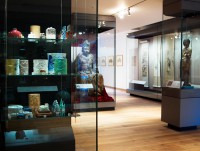Room 38 | China from AD 800 gallery
Explore key developments in the history and culture of China, from the arts and crafts of the Song Dynasty up to the present day.

High-fired ceramics with hard glazes have been made in China for more than 3000 years. Tang dynasty examples have white, black or green glazes. These glazes contain iron oxide, with the black being fired in a cleaner and more oxygen-rich atmosphere and the green in a smokier kiln with less oxygen.
The 9th-century greenwares from the Yue kilns in northern Zhejiang province on the east coast are amongst the most prestigious ceramics in China’s history. They were used by the emperor in Buddhist ceremonies, and are the subject of several Tang poems.
Greenware from Zhejiang province
 Greenware vase with floral decoration (EA1956.196)
Greenware vase with floral decoration (EA1956.196)
 Greenware ewer with incised lines (EA1956.215)
Greenware ewer with incised lines (EA1956.215)
 Greenware burial vase with spouts (EA1956.1237)
Greenware burial vase with spouts (EA1956.1237)
 Greenware burial-pot with incised lines (EA1956.659)
Greenware burial-pot with incised lines (EA1956.659)
 Greenware burial vase with lid in the form of a lotus (EA1956.199)
Greenware burial vase with lid in the form of a lotus (EA1956.199)
 Greenware vase with lotus leaves (EA1956.1298)
Greenware vase with lotus leaves (EA1956.1298)
 Greenware vase with floral decoration (EA1956.1221)
Greenware vase with floral decoration (EA1956.1221)
 Greenware vase with flower-shaped lid (EA1956.1225)
Greenware vase with flower-shaped lid (EA1956.1225)
 Greenware box with lotus flower (EA1956.1230)
Greenware box with lotus flower (EA1956.1230)
 Globular greenware jar (EA1956.292)
Globular greenware jar (EA1956.292)
 Greenware spittoon (EA1956.1202)
Greenware spittoon (EA1956.1202)
 Greenware box with two birds (EA1956.658)
Greenware box with two birds (EA1956.658)
 Greenware ewer with ornamental flanges (EA1956.260)
Greenware ewer with ornamental flanges (EA1956.260)
 Greenware lobed bowl (EA1956.314)
Greenware lobed bowl (EA1956.314)
 Greenware stand with floral decoration (EA1956.307)
Greenware stand with floral decoration (EA1956.307)
 Greenware box with floral decoration (EA1956.1212)
Greenware box with floral decoration (EA1956.1212)
 Greenware spittoon with square mouth (EA1956.289)
Greenware spittoon with square mouth (EA1956.289)
 Greenware globular jar with lotus petal decoration (EA1956.1216)
Greenware globular jar with lotus petal decoration (EA1956.1216)
 Greenware jar with lotus leaves (EA1956.1214)
Greenware jar with lotus leaves (EA1956.1214)
 Greenware jar with four loop-handles (EA1956.1206)
Greenware jar with four loop-handles (EA1956.1206)
 Globular greenware jar with lotus flower decoration (EA1956.1219)
Globular greenware jar with lotus flower decoration (EA1956.1219)
 Greenware cup stand with boy holding a tea-cup (EA1956.1228)
Greenware cup stand with boy holding a tea-cup (EA1956.1228)
 Greenware meiping, or plum blossom, vase (EA1956.1236)
Greenware meiping, or plum blossom, vase (EA1956.1236)
 Greenware vase in double-gourd form (EA1956.294)
Greenware vase in double-gourd form (EA1956.294)
White wares from north China
 White ware cup (EA1956.1113)
White ware cup (EA1956.1113)
 White ware bottle vase (EA1956.1123)
White ware bottle vase (EA1956.1123)
 White ware bottle vase (EA1956.1105)
White ware bottle vase (EA1956.1105)
 White ware cup (EA1956.1176)
White ware cup (EA1956.1176)
 White ware inkstone with taotie masks (EA1956.1116)
White ware inkstone with taotie masks (EA1956.1116)
 White ware box (EA1956.1166)
White ware box (EA1956.1166)
 White ware amphora with handles in the form of dragons (EA1956.1072)
White ware amphora with handles in the form of dragons (EA1956.1072)
 White ware jar (EA1956.1159)
White ware jar (EA1956.1159)
 White ware oil jar (EA1956.1108)
White ware oil jar (EA1956.1108)
 White ware bowl with ring handle (EA1956.1145)
White ware bowl with ring handle (EA1956.1145)
 Globular white ware bowl (EA1956.1137)
Globular white ware bowl (EA1956.1137)
 Miniature white ware vase (EA1956.1146)
Miniature white ware vase (EA1956.1146)
 White ware jar (EA1956.1111)
White ware jar (EA1956.1111)
 White ware trefoil-shaped box with lid (LI1301.314)
White ware trefoil-shaped box with lid (LI1301.314)
Black wares from north China
Dragon kiln, southern and eastern China
Dragon kilns measured up to 137 metres long and were built up hillsides, looking like the body of a dragon. The fuel was wood, placed in the firebox at the lower end and added through stokeholes along the sides. The best pots were those fired in the upper chambers, where the temperature and atmosphere were most even.
Sherds of Yue ware ceramics
The dense dark grey body is typical of wares from the Yue kiln sites, around the shores of Shanglin Lake in Zhejiang province. The decoration has been incised onto the clay before being covered in green glaze. The kings of the Wu Yue state had very fine pieces in their burials but the wares were also traded to northern China, the Middle East and Africa.
 Greenware sherd with floral decoration (EAP.5)
Greenware sherd with floral decoration (EAP.5)
 Greenware sherd from a pot (EAP.3)
Greenware sherd from a pot (EAP.3)
 Greenware sherd with floral decoration (EAP.7)
Greenware sherd with floral decoration (EAP.7)
Modern test strips of iron-coloured glazes
The strip on the left shows lime glazes fired at 1220 degrees celsius. The strip on the right shows lime-alkali glazes fires at 1250 degrees, which were favoured after the Tang dynasty.
The green glazes have been fired in a kiln less rich in oxygen. The precise shade depends on the kiln atmosphere and the titanium content of the glaze. The rate at which the pots cool down after firing affects the glaze texture.
See also
Notice
Objects may have since been removed or replaced from a gallery. Click into an individual object record to confirm whether or not an object is currently on display. Our object location data is usually updated on a monthly basis, so contact the Jameel Study Centre if you are planning to visit the museum to see a particular Eastern Art object.
© 2013 University of Oxford - Ashmolean Museum




